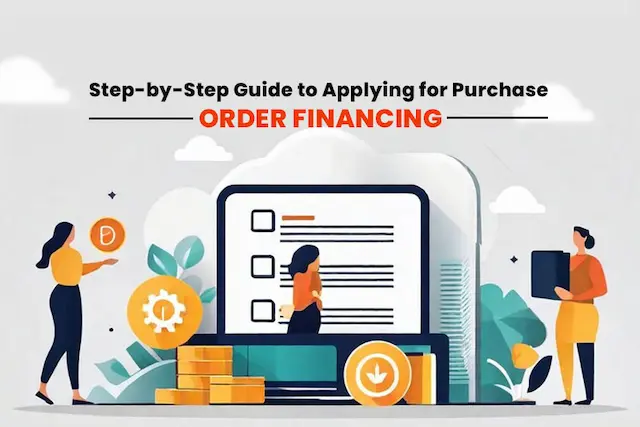Applying for purchase order financing can be a crucial step for small businesses looking to expand their operations without the immediate cash flow to fulfill large orders. While the process can be detailed and time-consuming, understanding the necessary steps and requirements can streamline your application and increase your chances of approval.
Here, we provide a comprehensive guide to help you navigate the application process and qualify for purchase order financing.
Step-by-Step Application Process of PO Financing
Here’s a step-by-step application process of PO Financing:
Conduct Due Diligence
Before you begin the application process, it’s essential to research and identify reputable purchase order financing providers. Evaluate their terms, interest rates, and requirements to find the best fit for your business needs.
Gather Required Documents
Different lenders may have varying documentation requirements, but typically, you will need to submit the following:
- Purchase Order from Your Customer: This document confirms the order details from your customer.
- Supplier’s Invoice to You: This shows the cost of goods you need to purchase from your supplier.
- Your Invoice to Your Customer: This reflects the amount you will charge your customer.
- Your Purchase Order to Your Supplier: This document confirms your order with the supplier.
- Business Information: General details about your business, including the nature of operations and ownership structure.
- Legal Information: Any pending lawsuits or legal actions involving your business.
- Financial Statements: Profit and Loss (P&L) statements, balance sheets, and other relevant financial documents.
- Tax Filings: Recent tax returns to demonstrate your financial stability and compliance.
Common Qualifying Criteria For Purchase Order Financing
While each lender has its own specific criteria for approval, companies that qualify for purchase order financing generally exhibit the following characteristics:
Nature of Business Operations
The borrowing company typically does not manufacture the products it sells. Instead, it purchases products from suppliers and resells them, often with added packaging or labeling. This model is common in industries such as wholesale distribution and retail, where the company acts as an intermediary between the supplier and the end customer. By focusing on reselling, these businesses can leverage purchase order financing to handle larger orders without tying up their own capital in inventory.
Transaction Size
The minimum sale price usually needs to be at least $50,000. Smaller transactions may not be eligible for purchase order financing due to the administrative costs involved. Larger transaction sizes ensure that the financing provided is cost-effective for both the lender and the borrower. This threshold helps cover the costs of due diligence, credit checks, and other administrative tasks. Therefore, companies aiming to qualify should structure their deals to meet or exceed this minimum amount to be considered for financing.
Profit Margins
The gross margin on the transaction should be at least 20%. Higher margins make the deal more attractive to lenders by providing a cushion for repayment and profitability. This margin is crucial because it indicates that the transaction is financially viable and that the borrower can comfortably cover the cost of financing. High-profit margins also ensure that the business can absorb any unexpected costs or delays, making the transaction less risky for the lender.
Customer Creditworthiness
The customer purchasing the goods must be creditworthy. Lenders will conduct a thorough credit check on your customers, looking for timely payment histories, absence of bankruptcies, and no significant litigation history. Some lenders perform business credit checks, while others rely on alternative methods to assess creditworthiness. A customer with a strong credit profile assures the lender that payments will be made on time, thereby reducing the risk associated with the transaction. It’s essential for the borrowing company to work with reputable customers who have a history of financial reliability.
Supplier Reliability
Your supplier should have a proven track record of delivering orders on time and meeting customer specifications. Lenders prefer dealing with reputable suppliers to minimize risks associated with order fulfillment. Reliable suppliers ensure that the goods meet quality standards and are delivered as promised, which is critical for maintaining customer satisfaction and ensuring that the borrowing company can fulfill its orders. A history of successful and timely deliveries by the supplier builds trust with the lender.
Non-Cancelable Transactions
The transaction must be non-cancelable, ensuring that the order will be fulfilled once the financing is provided. This reduces the risk for the lender and provides assurance of payment. Non-cancelable transactions guarantee that the purchase order will be completed, and the lender’s investment is secure. This contractual obligation eliminates the possibility of order cancellations, which could lead to financial losses for both the borrower and the lender.
Borrower’s Financial Standing
The borrowing company should have a good reputation and be in sound financial health. This includes a strong credit history, positive financial statements, and a stable business operation. A solid financial standing indicates that the company manages its finances well and can handle the responsibilities of additional financing. Lenders look for businesses that demonstrate consistent profitability, low debt levels, and effective cash flow management, as these factors reduce the risk of default.
Maximizing Your Chances of Approval
To maximize your chances of qualifying for purchase order financing, ensure that your business aligns with the above criteria. Maintain clear and detailed records of all transactions and financial statements, and work with reputable customers and suppliers. If your transactions are smaller than $50,000 or have lower profit margins, consider alternative financing options that might better suit your needs.
Also Read: A Complete Guide on Purchase Order Financing: What it is and How it works?
Conclusion
Assuming your small business meets the outlined criteria, purchase order financing can be an excellent tool to support your growth, enabling you to take on larger orders and expand your market presence. However, if your transactions do not meet the minimum requirements, exploring other financing solutions may be necessary to ensure your business continues to thrive.
By following these detailed guidelines and preparing thoroughly, you can navigate the purchase order financing application process with confidence and secure the funding needed to elevate your business to the next level.
Also Read: The Pros and Cons of PO Financing





